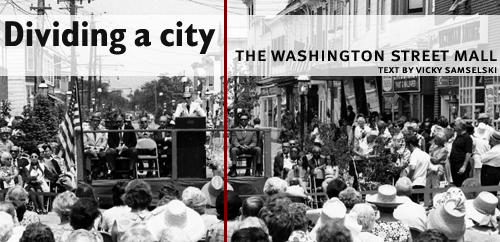
|
Those of us who already saw great potential for a new reality show called Cape May: The Soap Opera have to admit, the Washington Street Mall (hitherto known as The Mall) seemed destined to become an even more popular spin-off. From the day The Mall first opened as a separate pedestrian area back in 1971, maturing and changing slightly apart from the rest of the island, seeming to become a city-within-a-city. It has its own culture, its own speed, and its own separate army of uniformed candy sirens handing out fudge. From its very beginnings, The Mall divided people in this city. It may have, in fact, been the catalyst for major changes that shaped the island. Certainly it was the centerpiece in a long line of civic projects to shape the future of this town.
The entire county began to change just after the rather inauspicious (according to former Mayor Bruce Minnix) ribbon-cutting he says he presided over as the new mayor back in 1972. Former Mayor Frank Gauvry insists he presided over the actual ribbon-cutting in June of 1971 – and we’re already off to a great start. Just to set the record straight – the dedication of the Washington Street Mall took place on June 24, 1971. Ahh, the '70s. When we pick eras to feel nostalgic for, let’s all remember that the 70s were among the uglier and more depressing parts of our history. In Cape May alone the water pollution was at its all-time high; buildings neglected since the '40s and '50s were reaching a critical breaking point; and the unemployment rate was higher than in the rest of the U.S. (up to 28.6 % of the county’s population was unemployed in the winter of 1976 – the national average was 7.3%). There was a remarkably volatile election on the island – Minnix challenging the incumbent Gauvry. And we haven’t even mentioned polyester leisure suits yet. Is it any wonder people began to look back in time for beauty and charm? For Cape May as we know it, the time was a watershed. People of this city began to complain, and then to fight, and finally to work together. The Washington Street Mall project was a revolution of sorts – no matter whose version you’re hearing. In March of 1966, City Planner John Needles, City Manager David Teel, and Mayor Frank Gauvry met in Washington, D.C. with officials from Housing and Urban Development (HUD) to raise federal money to rebuild Cape May. “It was not a very attractive commercial area,” says Frank Gauvry today. “The buildings along Washington Street were in desperate need of repair. So, we looked for ways to change.”
“Everybody was against the Mall,” says Gauvry. “They almost ran me out of town. But as soon as it was successful, everyone wanted in. I think it had a great deal to do with revitalizing the commercial aspects of the city.” Public housing on Lafayette Street was the other side of that coin. The city ended up destroying much of a historically important (and thriving) African-American community when they tore down the buildings along Lafayette to create low-income HUD housing as part of the agreement. And thus began the first swell of controversy towards Urban Planning.
The sound of wrecking balls throughout the City set more people into action – to stop it. Bruce Minnix, Gregory Ogden, Ray Schultz, and many others began forming a group that would later become the Mid-Atlantic Center for the Arts (MAC.) Their purpose was to stop the razing of the old buildings – one in particular: the Physick Estate. Everything wrong, and everything right, about the city’s efforts at self-preservation began to swirl around two locations: The Mall, and the then-derelict Physick Estate. You just can’t mention one without the other; both were needed, both had ardent supporters, both had a role to play. If it hadn’t been for the city’s refusal to allow the sale of the Physick Estate to MAC to save the building, Bruce Minnix would never have been mayor. Minnix, Jerry Inderweiss (who was later elected mayor as well) and John Daly were picked by a group of concerned citizens to run against Gauvry and his council.
Minnix ran a campaign based on beating the good ole boy system, the top-down government, and the destruction of old architecture city-wide. He won the most votes out of the three, and became mayor in 1972. “My first official act, the only business on the day we were sworn in, was to acquire the grant to buy the Physick Estate,” says Minnix. Restoration of that landmark began immediately. “My last act, after four years of great fun, was to accept the designation of [National] Historic Landmark.” In between those two events, a
little business of a new pedestrian mall came to Bruce’s attention. “The Mall
was almost done by then – 95%. But they’d run out of money for it! They gave
money to people to write a song for the town, all these
A mixture of great ideas and poor planning shouldn’t surprise. Any city of any size that now boasts of a “revitalized downtown shopping district” or a “Main Street” paid for with federal funds is a direct descendent of the Washington Street Mall. At the time, however, the only thing the City of Cape May agreed on was their hatred of the mall. “The only friend I had, the only person who thought it would work,” says Gauvry now, “Was Vince Casale, at Casale’s Shoes. I was very unpopular.” Gauvry hints that when the money started rolling in, certain people immediately pretended to be more involved with The Mall planning than they actually were.
Meanwhile, families started fixing up their summer shacks, turning them into beach palaces – and then divvying them up into duplexes and, later, condos. A distinctive service industry was born with the creation of a B&B industry, not to mention the niche marketing to that core group of Victoriana enthusiasts whose interest quickly spread to everything from buying antiques to enjoying vintage American plays performed after decades of being forgotten. Everything we offer in this town, right up to the new wineries, comes from the attitude that the finer things last. But did they forget to look ahead? | ||
 For the full article, please pick up the July 2008 issue of Cape May Magazine, available in local stores or by visiting our website www.capemaymag.com. | ||


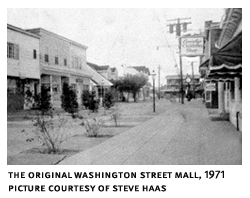 Their first order of business was
to build a “Victorian Village Shopping Mall” that would use authentic Victorian
buildings to recreate the town as it had been during its boom-times in the late
1800s. This would attract tourists and create a sweet little boost to both taxes
and jobs at a time when both were needed. The restoration efforts would also be
a huge step toward the eventual listing of the entire city of Cape May on the
National Registry of Historic Places. Think of all the revenue to come through
this place since we won that honor, and you might understand the passion that
accompanies any change in this town.
Their first order of business was
to build a “Victorian Village Shopping Mall” that would use authentic Victorian
buildings to recreate the town as it had been during its boom-times in the late
1800s. This would attract tourists and create a sweet little boost to both taxes
and jobs at a time when both were needed. The restoration efforts would also be
a huge step toward the eventual listing of the entire city of Cape May on the
National Registry of Historic Places. Think of all the revenue to come through
this place since we won that honor, and you might understand the passion that
accompanies any change in this town.
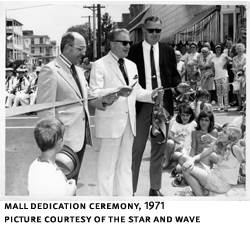 “Our first project was the
low-income housing,” says Frank Gauvry. “There were blocks of uninhabitable
houses – and people were living in them. We tore all those down, it was all part
of the whole idea of revitalizing. Our second project was the Acme shopping
area, aka Victorian Village, now called Washington Commons. It had been a
railway station, a gas station and a coal yard. Then we rebuilt Convention Hall
– it was [done] entirely [with] city workforce, [and] cost about $250,000. Then
Village Green, then The Mall, and then Victorian Towers. Look at all we did in
just eight years,” he adds. Gauvry served as mayor from 1964 to 1972. “It was
just the three of us running the City! There’s too many cooks in the kitchen
today; it hinders growth.”
“Our first project was the
low-income housing,” says Frank Gauvry. “There were blocks of uninhabitable
houses – and people were living in them. We tore all those down, it was all part
of the whole idea of revitalizing. Our second project was the Acme shopping
area, aka Victorian Village, now called Washington Commons. It had been a
railway station, a gas station and a coal yard. Then we rebuilt Convention Hall
– it was [done] entirely [with] city workforce, [and] cost about $250,000. Then
Village Green, then The Mall, and then Victorian Towers. Look at all we did in
just eight years,” he adds. Gauvry served as mayor from 1964 to 1972. “It was
just the three of us running the City! There’s too many cooks in the kitchen
today; it hinders growth.”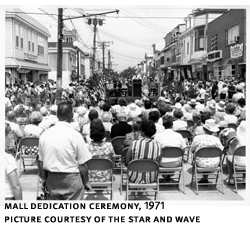 “We had become very involved in
saving the Physick Estate,” said Minnix recently. “The city had the grant money
to buy it, but wasn’t moving. They were just going to let it be torn down. My
wife said ‘Everyone knows you can’t win, but you’ve got a big mouth – do the
best you can.’ ”
“We had become very involved in
saving the Physick Estate,” said Minnix recently. “The city had the grant money
to buy it, but wasn’t moving. They were just going to let it be torn down. My
wife said ‘Everyone knows you can’t win, but you’ve got a big mouth – do the
best you can.’ ” 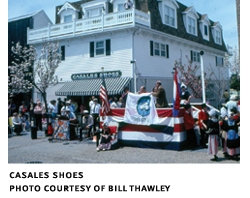 things… and then ran out
of money for trees. Go figure. So we drove up to Middle Township, got some cedar
trees from their high school – we had permission – and planted them. We didn’t
have any money.”
things… and then ran out
of money for trees. Go figure. So we drove up to Middle Township, got some cedar
trees from their high school – we had permission – and planted them. We didn’t
have any money.” 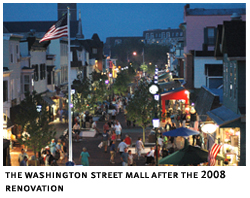 Key people shaped the look of the
town, the amenities they included, even what the city’s populace did for fun.
And if it just so happened to be profitable, or at the very least commercially
feasible, were they seen as anti-conservation?
Key people shaped the look of the
town, the amenities they included, even what the city’s populace did for fun.
And if it just so happened to be profitable, or at the very least commercially
feasible, were they seen as anti-conservation?